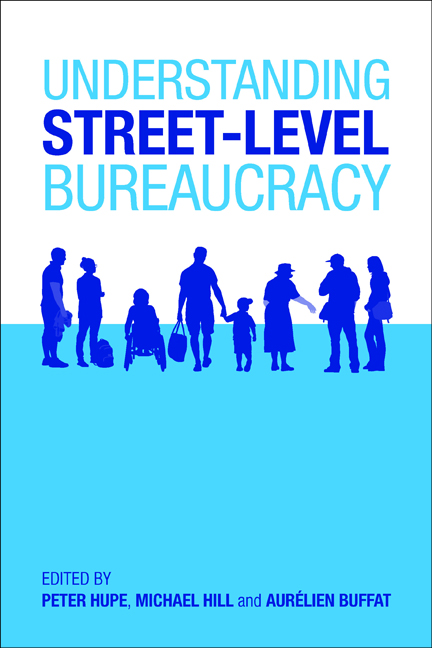Book contents
- Frontmatter
- Contents
- Biographical notes
- Preface
- Part One Introduction
- Part Two Delivering services and benefits: street-level bureaucracy and the welfare state
- Part Three Agents of the state: street-level bureaucracy and law enforcement
- Part Four Embedded in society: street-level bureaucrats as public actors
- Part Five The management of street-level bureaucrats
- Part Six The promise of professionalism
- Part Seven Conclusion
- References
- Index
Seventeen - The moment of the street-level bureaucrats in a public employment service
Published online by Cambridge University Press: 08 March 2022
- Frontmatter
- Contents
- Biographical notes
- Preface
- Part One Introduction
- Part Two Delivering services and benefits: street-level bureaucracy and the welfare state
- Part Three Agents of the state: street-level bureaucracy and law enforcement
- Part Four Embedded in society: street-level bureaucrats as public actors
- Part Five The management of street-level bureaucrats
- Part Six The promise of professionalism
- Part Seven Conclusion
- References
- Index
Summary
Introduction
Over the last decade, Germany fundamentally changed its labour market policies, following the developments in many other European countries that focused on the task of ‘activation’, new management ideas and new forms of governance (Eichhorst and Konle-Seidl, 2008; Eichhorst et al, 2008; Weishaupt, 2010). From 2002, the former red–green government under Chancellor Gerhard Schröder had put the so-called ‘Hartz reforms’ into effect, which were much praised for their success (Fehr and Sunde, 2009; Koch et al, 2009). Nevertheless, the reforms were also the subject of controversial public debate and were often seen as a means to curb the supposedly expanding welfare state. One of the central aims was to cut down the costs of unemployment by reducing the maximum duration of unemployment insurance benefits and integrating the unemployment and social assistance schemes into one benefit for the long-term unemployed and other needy job seekers (Fleckenstein, 2008). The reforms also referred to Giddens's (1986) idea of a new balance of ‘rights and obligations’ between the state and citizen, enhancing mutual responsibilities and contractual relationships.
The Federal Employment Agency (FEA; Bundesagentur für Arbeit) found itself under immense political pressure to increase efficacy and efficiency because of exaggerated and partly faked statistical data concerning job placements. The third law of the Hartz legislation (Hartz III) aimed at restructuring the FEA to enable it to provide modern services on the labour market (including a ‘one-stop-shop system’; see Konle-Seidl, 2009). The FEA ought to be a service provider instead of a bureaucratic organisation, treating citizens as ‘clients’ on equal terms by, on the one hand, promoting support and enabling its clients and, on the other hand, demanding cooperation and increased efforts from job seekers (‘carrots and sticks’ or ‘ Fördern und Fordern ’). This was also a challenging task for the FEA's caseworkers, who have been expected to act like counsellors instead of bureaucrats ever since. In general, caseworkers play an increasingly important role in practically implementing activation policies that require the individual treatment of clients (Borghi and Van Berkel, 2007).
Another major aspect of the reforms was the restructuring of unemployment benefits and legal responsibilities for counselling through the fourth Hartz law (Hartz IV), officially known as Social Code II.
- Type
- Chapter
- Information
- Understanding Street-Level Bureaucracy , pp. 295 - 312Publisher: Bristol University PressPrint publication year: 2015
- 3
- Cited by

